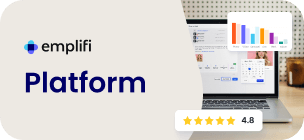Personalized marketing is the practice of using audience data – such as demographics, interests, and online behavior – to deliver messages and experiences tailored to each customer’s needs.
In simple terms, it’s about relevance. Brands collect and analyze data to create content that speaks directly to individual users, making it more likely to capture attention, build trust, and drive action.
You’ve seen personalized content in action, whether it’s Netflix recommending your next binge-worthy show or a brand serving up a social ad that feels like it was made just for you. These experiences aren’t coincidences. They’re built on algorithms, insights, and a growing expectation from consumers that brands know them.
So what does all this mean for your brand’s social strategy? Let’s explore why personalization matters, and how to make it work on social media in 2025.
Your customers expect personalized content
Consumers aren’t simply open to personalized experiences — they expect them in 2025. Especially on social media, relevance is the baseline. Brands that deliver content tailored to a user’s interests, needs, and identity are far more likely to earn engagement, trust and, ultimately, sales.
According to Emplifi’s 2025 Consumer-Brand Social Engagement Survey, 65% of social media users say that content from real customers and followers is most likely to prompt a purchase, more than twice the influence of traditional influencer content. What do these user-generated posts have in common? They feel personal, relatable, and authentic.
This isn’t really about tone at the end of the day. It’s about targeting. Posts that “feel geared toward people in my age group” influence 25% of all consumers, and up to 34% of Gen Z. Humor, visual appeal, and topicality also rank highly among the traits that make content feel relevant.
The takeaway: Generic content gets ignored. To stand out, brands must treat audiences not as a monolith, but as individuals. And use data to deliver the right message, to the right person, at the right moment. Every time.
What personalized marketing unlocks for your brand
Personalized marketing goes far beyond just keeping up with consumer expectations. It’s also a key driver of business outcomes across the funnel. Here’s what happens when brands get it right:
- Higher engagement: Content that reflects a user’s interests or identity is far more likely to earn likes, comments, and shares. The more relevant your post, the more visible it becomes, especially in algorithm-driven feeds.
- Better campaign performance: Personalization improves click-through rates, lowers paid media costs, and increases the likelihood that social users will take meaningful action.
- Stronger conversions: Personal content drives results. Consumers are more likely to buy when they feel seen, especially among younger generations. In our latest data, 42% of Gen Z say the look of a post influences their purchase decisions, and 34% say they’re more likely to buy when the post feels geared toward their age group.
- Deeper loyalty and advocacy: Personalized messages make customers feel understood, not marketed to. That connection builds loyalty, and loyal customers spread the word.
- Greater long-term ROI: Personalized marketing compels action today, but it also builds brand equity over time. It’s one of the few tactics that boosts both short-term wins and long-term growth.
Personalizing your marketing starts with understanding your audience
You can’t personalize what you don’t understand. If you want to deliver social content that feels relevant, timely, and valuable, it starts with getting a full picture of who your audience is and what matters to them.
That means going beyond basic demographics. Today’s best marketers use a mix of first-party data, social listening tools, and cross-channel analytics platforms to identify:
- Age, location, and interests
- Preferred platforms and content formats
- Follower behavior (likes, shares, DMs, tags)
- Which influencers or creators they engage with
- Where they are in the customer journey
This is how you move from general assumptions to audience intelligence, and it’s the foundation of any effective personalization strategy.
It’s also where AI is becoming a game changer. Tools like Emplifi’s Unified Analytics help brands surface audience segments in real time, analyze which types of content resonate most by segment, and predict what topics will perform next. This makes it easier to build dynamic personas that evolve as your audience does, not static profiles that go stale after a campaign ends.
And don’t overlook how your audience moves between channels. Social interactions, clicks, site visits, and cart behavior all tell a story. The more you can unify that data, the easier it is to personalize touchpoints across the customer journey rather than just within a single post.
Example of a buyer persona profile
Here’s an example of a B2C buyer persona profile that can form the basis of a brand’s personalization strategy.
Sample audience segment: Trend-seeking Gen Z skincare fans
- Key attributes:
- Age: 18–25
- Primary platforms: Instagram, TikTok
- Content behaviors: Engages with skincare routines, UGC videos, tutorials
- Favorite creators: @skincarebyhyram, @glowwithava
- Common traits: Prefers humor + how-to, values ingredient transparency
- Purchase behavior: Often buys from TikTok Shop after watching demos

8 smart ways to personalize your social media marketing
Once you understand your audience, it’s time to take action. For personalization to be effective, you have to do more than say the right thing. You need to deliver the right message, in the right format, at the right time, to the right people. These eight tactics can help you scale personalized marketing across your social media strategy in meaningful, measurable ways.
1. Segment your audience by behavior, not just demographics
Don’t rely solely on age or location. Modern social media analytics tools give you insights into how your audience behaves: what they engage with, how often they buy, and what they care about. Use that information to build high-intent segments like frequent engagers, content sharers, repeat buyers, or first-time visitors. The deeper the behavioral insight, the more relevant your messaging can be.
2. Use AI to scale tailored content
AI supercharges your ability to personalize at scale. With the help of tools like Emplifi’s Unified Analytics and AI Composer, brands can generate copy variations, adjust brand voice by audience, and automatically crop visuals for each channel. You can even use AI to suggest the best CTA based on past engagement data, or personalize entire posts for different customer segments, without needing a team of 10.
3. Customize your publishing schedule
Not all audiences are online at the same time. Use insights from each platform to time posts around your audience’s peak activity and don’t assume one schedule fits all. For example, Gen Z users may be more active on TikTok late at night, while Millennial parents may check Instagram during early mornings or lunch breaks. Even small timing shifts can boost visibility and engagement.
4. Feature UGC that reflects your audience
User-generated content (UGC) performs best when it feels like the viewer. That’s likely why 65% of consumers say customer and follower content is more likely to prompt a purchase than influencer content, according to Emplifi’s research. Reposting real customers with similar demographics or interests to your target audience makes your brand feel authentic and relatable – and reinforces the idea that “people like me” love your product.
5. Personalize across the full customer journey
Personalization doesn’t stop at the first click. Tailor content for every stage of the journey, from awareness to conversion to loyalty. For example:
a. Awareness: Use topical, eye-catching content to introduce your brand.
b. Consideration: Share product demos, reviews, or comparison guides.
c. Conversion: Offer time-limited discounts or bundles.
d. Retention: Celebrate milestones, highlight tips for existing users, or launch loyalty-focused campaigns.
Many brands overlook retention, but social media is a powerful channel to build long-term brand love after the sale.
6. Vary your tone and message by segment
The same message won’t resonate equally with every group. Gen Z often responds to humor, informality, and lo-fi content. Boomers tend to value clarity, usefulness, and authenticity. Millennials love lifestyle storytelling and social causes. Tailoring your tone, length, format, and aesthetic by segment can dramatically improve engagement and sentiment.
7. Retarget based on social behavior
Every click, save, like, or comment tells you something — if you’re listening. The key question to ask after someone engages with a post is: “What does this tell us about them?”
Did they click because they’re ready to buy? Because they’re interested in seeing more content like that? Or simply because the post was entertaining or funny? Your answer should shape what, if anything, you show them next.
For example:
a. Someone who watches a product demo all the way through might be ready for a follow-up offer.
b. A user who comments on a new collection reveal might be primed for early access.
c. Someone who saves a behind-the-scenes video might want more content about your brand’s story or values.
Test different follow-up content to validate your assumptions and refine your retargeting logic over time. The most effective personalization doesn’t just react to behavior. It interprets the why behind it.
8. A/B test personalization tactics
Don’t assume — test. Run experiments to see which personalization tactics actually move the needle. Is your Gen Z audience more likely to click on funny videos or heartfelt testimonials? Do time-sensitive CTAs outperform evergreen messages for repeat buyers? The more you test and learn, the better you can tailor each campaign to perform at its peak.

Real-world examples of personalized marketing in action
Personalization looks different for every brand, but the goal is the same: deliver content and experiences that resonate on an individual level. Here’s how three Emplifi customers are using personalized marketing on social media to drive engagement, loyalty, and impact.
Delta Air Lines: Personalizing care for millions of travelers
Delta uses Emplifi to manage millions of social interactions annually, not just efficiently, but personally. Their team listens to real-time traveler feedback across platforms, tailoring responses based on each customer’s unique situation. Whether it’s a traveler tagging them from an airport terminal or DMing about a delayed flight, Delta uses social listening and customer context to respond quickly, helpfully, and in a tone that matches the moment.
Why it works:
By combining scale with personalization, Delta strengthens trust with travelers and turns social media into a retention and loyalty channel, not just a place for complaints.
Domino’s: Blending automation and empathy for real-time engagement
Domino’s works with Emplifi to deliver fast, brand-consistent support across every major social platform. Their social team tailors messaging based on what customers are saying, where they’re saying it, and what tone fits the situation. It not only increases the speed of responses, but it uses automation to route conversations smartly, while preserving the human voice their customers know and love.
Why it works:
Social care is marketing, and Domino’s ensures every reply reinforces the brand, turning service moments into brand-building opportunities.
Navy Hair Care: Using UGC to reflect the customer’s world
Rather than rely on influencer campaigns or branded photoshoots, Navy Hair Care fills its social feeds with content from real customers — people who look, speak, and live like the audience they’re trying to reach. This curated approach helps their posts feel more personal and trustworthy, while boosting engagement and community.
Why it works:
Emplifi’s 2025 consumer survey found that 65% of consumers are more likely to buy from posts featuring real customers than from traditional influencer content. Navy Hair Care makes that insight the core of its content strategy.
The path to personalized marketing starts with knowing your audience
In 2025, social media is where consumers expect real connection. Personalized marketing helps you meet people where they are, with content that feels like it was made just for them. And when you get it right, it drives real business outcomes: stronger engagement, better conversion rates, and long-term brand loyalty.
But personalization isn’t a one-time campaign. It’s a strategy that evolves with your audience and the tools you use to understand and engage them.
Emplifi gives you the power to bring personalization to life at scale. From AI-powered insights to cross-channel engagement tools, we help brands deliver social experiences that feel personal, relevant, and human, no matter how large your audience is.
Ready to see how Emplifi can help your team scale personalization with impact? Let’s talk.

























